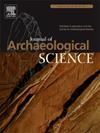磷壳作为鉴别考古动物圈闭区的宏观和微观指标
IF 2.6
1区 地球科学
Q1 ANTHROPOLOGY
引用次数: 0
摘要
本文介绍了一种新的宏观和微观证据,用于鉴定考古动物圈闭区:磷化结壳。尽管放牧活动对重建古代社区的社会、经济和生态方面具有重要意义,但动物圈养区域的证据传统上依赖于模糊的建筑痕迹或微观指标,这些往往难以在实地识别。本研究采用多学科方法,结合实地观察、地质考古学、脂质生物标志物和微生物学分析,对最近在意大利东北部维罗纳的La Muraiola di Povegliano青铜时代中期(公元前1650-1300年)遗址发现的磷壳进行了研究。分析揭示了磷壳形成背后的过程,强调了动物喷出物浓度在纳米晶部分碳化羟基磷灰石胶结矿床中的关键作用。这种多代理方法进一步表明,磷结壳是研究空间利用、牲畜管理(如自由放牧/禁闭、牲畜种类、饲料)和人-动物-环境相互作用的重要档案。本文章由计算机程序翻译,如有差异,请以英文原文为准。
Phosphatic crusts as macroscopic and microscopic proxies for identifying archaeological animal penning areas
This study introduces new macroscopic and microscopic evidence for identifying archaeological animal penning areas: phosphatic crusts. Despite the importance of herding activities for reconstructing the social, economic, and ecological aspects of ancient communities, evidence for animal penning areas has traditionally relied on faint architectural traces or microscopic indicators that are often challenging to identify in the field. By employing a multidisciplinary approach that combines field observations, geoarchaeology, lipid biomarker, and microbotanical analyses, this research examines the phosphatic crusts recently identified at the Middle Bronze Age (1650-1300 BCE) site of La Muraiola di Povegliano (Verona, north-eastern Italy).
The analyses uncover the processes behind phosphatic crust formation, highlighting the key role of the concentration of animal ejecta in the cementation of the deposit by nanocrystalline partially carbonated hydroxylapatite. This multi-proxy approach further demonstrates that phosphatic crusts serve as crucial archives for investigating the use of space, livestock management (e.g., free grazing/confinement, livestock species, foddering), and human-animal-environment interactions.
求助全文
通过发布文献求助,成功后即可免费获取论文全文。
去求助
来源期刊

Journal of Archaeological Science
地学-地球科学综合
CiteScore
6.10
自引率
7.10%
发文量
112
审稿时长
49 days
期刊介绍:
The Journal of Archaeological Science is aimed at archaeologists and scientists with particular interests in advancing the development and application of scientific techniques and methodologies to all areas of archaeology. This established monthly journal publishes focus articles, original research papers and major review articles, of wide archaeological significance. The journal provides an international forum for archaeologists and scientists from widely different scientific backgrounds who share a common interest in developing and applying scientific methods to inform major debates through improving the quality and reliability of scientific information derived from archaeological research.
 求助内容:
求助内容: 应助结果提醒方式:
应助结果提醒方式:


